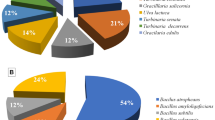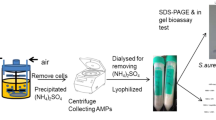Abstract
A microorganism isolated from the Sundarbans region of the Bay of Bengal, India, showed potent antimicrobial activity against gram-positive and gram-negative bacteria, molds, yeast and several multiple-drug-resistant (MDR) bacteria, including methicillin-resistant Staphylococcus aureus (MRSA). The isolate grew in the presence of 20% (w/v) NaCl, antibiotic production being maximum with 5% (w/v) NaCl in the production medium. Natural seawater stimulated antibiotic biosynthesis. The absence of catabolite repression during the synthesis of the antimicrobial substance was demonstrated by the utilization of glucose by this isolate. The 16S rRNA gene of this aerobic, gram-positive, mycelium- and spore-forming microorganism was amplified, and molecular phylogenetic analysis of the DNA sequence showed less than 93% similarity with its closest relative, indicating differentiation at the genus level. The highly stable, active principle was purified by butyl acetate extraction and silica-gel chromatography and a single compound was found to posses the broad-spectrum activity. Molecular characterization showed that the active compound is a lipid. Bioreactor studies demonstrated that antibiotic production is strongly dependent on the scale of operation and there is a definite relation between the dissolved oxygen concentration, medium pH, glucose utilization, cell differentiation and antibiotic production. Maximum production in 30 h could be obtained by regulation of the medium pH in the alkaline range by a combination of controlled addition of NaOH, regulation of the air supply and changes in the reactor configuration. Considering all of the above evidences and based on comparison with the current literature, a novel antimicrobial appears to have been isolated.







Similar content being viewed by others
References
Akeda Y, Shibata K, Ping X, Tanaka T, Taniguchi M (1995) AKD-2A, B, C and D, new antibiotics from Streptomyces sp. OCU-42815, taxonomy, fermentation, isolation, structure elucidation and biological activity. J Antibiot (Tokyo) 48:363–368
Alm EW, Oerther DB, Larsen N, Stahl DA, Raskin L (1996) The oligonucleotide probe database. Appl Environ Microbiol 62:3557–3559
Altschul SF, Gish W, Miller W, Myers EW, Lipman DJ (1990) Basic local alignment search tool. J Mol Biol 215:403–410
Bordoloi GN, Kumari B, Guha A, Bordoloi M, Yadav RN, Roy MK, Bora TC (2001) Isolation and structure elucidation of a new antifungal and antibacterial antibiotic produced by Streptomyces sp. 201. Biosci Biotechnol Biochem 65:1856–1858
Devereux R, He SH, Doyle CL, Orkland S, Stahl DA, LeGall J, Whitman WB (1990) Diversity and origin of Desulfovibrio species: phylogenetic definition of a family. J Bacteriol 172:3609–3619
Dobson SJ, McMeekin TA, Franzmann PD (1993) Phylogenetic relationships between some members of the genera Deleya, Halomonas, and Halovibrio. Int J Syst Bacteriol 43:665–673
Feling RH, Buchanan GO, Mincer TJ, Kauffman CA, Jensen PR, Fenical W (2003) Salinosporamide A: a highly cytotoxic proteasome inhibitor from a novel microbial source, a marine bacterium of the new Genus Salinospora. Angew Chem Int Ed Engl 42:355–357
Fiedler HP, Nega M, Pfefferle C, Groth I, Kempter C, Stephan H, Metzger JW (1996) Kanchanamycins, new polyol macrolide antibiotics produced by Streptomyces olivaceus Tu 4018. I. Taxonomy, fermentation, isolation and biological activities. J Antibiot (Tokyo) 8:758–764
Heuer H, Kresk M, Baker P, Smalla K, Wellington EMH (1997) Analysis of Actinomycete communities by specific amplification of genes encoding 16S rRNA and gel-electrophoretic separation in denaturing gradients. Appl Environ Micobiol 63:3233–3241
Hsu FF, Turk J (2004) Characterization of acylphosphatidylglycerols from Salmonella typhimurium by tandem mass spectrometry with electrospray ionization. J Am Soc Mass Spectrom 15:1–11
IMTECH (1998) Laboratory manual on Actinomycetes: isolation, screening, identification and gene cloning in Streptomyces. Institute of Microbial Technology, Chandigarh, pp 64–65
Kwon HJ, Smith WC, Longkuan X, Shen B (2001) Cloning and heterologous expression of the macrotetrolide biosynthetic gene cluster revealed a novel polyketide synthase that lacks an acyl carrier protein. J Am Chem Soc 123:3385–3386
Marwick JD, Wright PC, Burgess JG (1999) Bioprocess intensification for production of novel marine antibiotics through bioreactor operation and design. Mar Biotechnol 1:495–507
Mincer TJ, Jensen PR, Kauffmann CA, Fenical W (2002) Widespread and persistent populations of a major new marine Actinomycete taxon in ocean sediments. Appl Environ Microbiol 68:5005–5011
Mulks MH, Nair MG, Putnam AR (1990) In vitro antibacterial activity of faeriefungin, a new broad-spectrum polyene macrolide antibiotic. Antimicrob Agents Chemother 34:1762–1765
Proksch P, Edrada R, Ebel R (2002) Drugs from the seas-current status and microbiological implications. Appl Microbiol Biotechnol 69:125–134
Saitou N, Nei M (1987) The neighbor-joining method: a new method for reconstructing phylogenetic trees. Mol Biol Evol 4:406–425
Stach JEM, Maldonado LA, Ward AC, Goodfellow M, Bull AT (2003) New primers for the class Actinobacteria: application to marine and terrestrial environments. Environ Microbiol 5:828–841
de Swaaf M, Pronk J, Sijtsma L (2003) Fed-batch cultivation of the docosahexaenoic-acid-producing marine alga Crypthecodinium cohnii on ethanol. Appl Microbiol Biotechnol 61:40–43
Tateno H, Goldstein IJ (2003) Molecular cloning, expression, and characterization of novel hemolytic lectins from the mushroom Laetiporus sulphureus, which show homology to bacterial toxins. J Biol Chem 278:40455–40463
Thompson JD, Higgins DG, Gibson TJ (1994) CLUSTAL W: improving the sensitivity of progressive multiple sequence alignment through sequence weighting, positions-specific gap penalties and weight matrix choice. Nucleic Acids Res 22:4673–4680
Woo JH, Kamei Y (2003) Antifungal mechanism of an anti-Pythium protein (SAP) from the marine bacterium Streptomyces sp. strain AP77 is specific for Pythium porphyrae, a causative agent of red rot disease in Porphyra spp. Appl Microbiol Biotechnol 62:407–413
Yan L, Boyd KG, Burgess JG (2002) Surface attachment induced production of antimicrobial compounds by marine epiphytic bacteria using modified roller bottle cultivation. Mar Biotechnol 4:356–366
Yan L, Boyd KG, Adams DR, Burgess JG (2003) Biofilm-specific cross-species induction of antimicrobial compounds in Bacilli. Appl Environ Microbiol 69:3719–3727
Acknowledgments
Financial support from the All India Council for Technical Education (Grant no. 8019/RDII/R&D/BIO(135)200-01), Department of Science and Technology, New Delhi (Grant no. SR/FTP/LS-A-016/2001) to J. Mukherjee and Indian Council of Medical Research fellowship (No. 45/26/2001/Pharma/BMS) to M. Saha is thankfully acknowledged. Special thanks to Dr T. Sen for help during the toxicity tests.
Author information
Authors and Affiliations
Corresponding author
Rights and permissions
About this article
Cite this article
Saha, M., Ghosh, D., Ghosh, D. et al. Studies on the production and purification of an antimicrobial compound and taxonomy of the producer isolated from the marine environment of the Sundarbans. Appl Microbiol Biotechnol 66, 497–505 (2005). https://doi.org/10.1007/s00253-004-1706-3
Received:
Revised:
Accepted:
Published:
Issue Date:
DOI: https://doi.org/10.1007/s00253-004-1706-3




